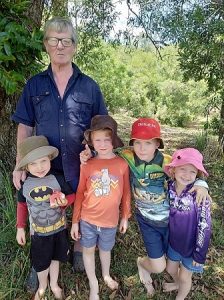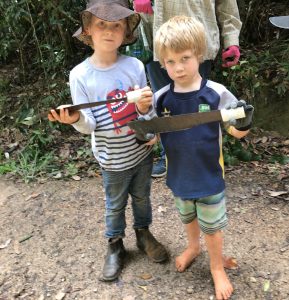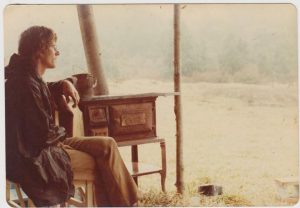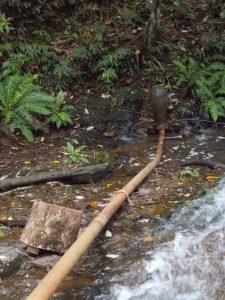I have sought and found a different lifestyle than most people in Australia and I hope dear readers find some interest and amusement in me relating tasks and events and trying to give some impression of what it is like to live and work in rainforest. First off, I don’t commute. My work and pleasure is all around, me so I can step out the door and do something. I guess there are a lot of people who could better use the time and money commuting bleeds from them. Also being self-employed and the B&B business requiring work mainly in the middle of the day, I can get up when I feel like it for a leisurely shower and breakfast. I am past the morning scramble to get the kids to the school bus. So life is not too demanding so far, and I do have the choices of what I do. My own priorities.
First some treats. I enjoy talking and socializing with guests. Most I treat with respect and care and having shown them round and orientated them to Possum Valley, I leave them to their own devices. Some who return and show some interest in conversation I get to know better, invite to dinner, or get invited and have a most convivial time. Recently I had an evening with frequent flyer guests of two young teenage boys and their father, as the mother had stayed home to look after a newly acquired puppy. The boys expertly taught me some new card games and we had a lot of fun. Also I heard the tale of the heroic mother, hi Nadege, who saved the puppy from a large python. The boys and puppy were asleep in a room of their home in Cairns, when Nadege heard some disturbance. She entered the room and the boys were fast asleep and a python had the nose of the puppy in its jaws and coils around its body. I had always seen the gentle side of this lady, but had suspected there was also a fierce side. The fierce side sprang into action and ripped the python off the doomed puppy and flung it towards the door but missed. I am sure you know how difficult it is to aim a heavy and powerful wriggling serpent at a target …. or perhaps you don’t. It hit the wall with a mighty thud and dived for cover in the boys bedroom. The household and serpent were in uproar by this time, blood everywhere, the dozing father now on the scene and the snake chased out. This will go down in family legend. Don’t mess with Nadege or her loved ones.
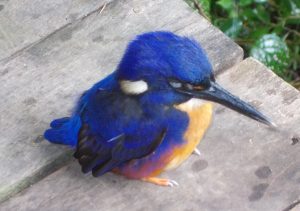
A little treat of an azure kingfisher on my veranda
My last weekly supplies run to Atherton had a happy end when I came back along the track to see a cassowary striding along. It took off into the bush and when I pulled up to where it disappeared, just waving bushes to be seen. So I drove off and 70 m later it dashed out of the forest right in front of the car and crashed into the foliage on the other side of the road. I think this is one of the wild ones. A couple of hundred meters later, I met guests on the way out and cautioned them to take care on the road because of a cassowary. They would have loved to have seen it, but didn’t.
Now some of the toil. Bom had forecast that a low off the coast would turn into a cyclone category 3, but would not cross the coast. On Monday I woke up to gale force winds and and lashing rain driven by vicious gusts. But the eerie bit was how dark it was. The whole day my solar panels couldn’t harvest a single amp of power. Which would have been useful as about 9am the hydro went offline not producing any power either. I thought about the rain raising the creek and bogging the turbine, but there had not been enough rain to cause that so it was likely an open circuit with a break in the transmission line or a fallen branch bringing the lines together to produce a short circuit. Either way I had to shut down the turbine.
I got into my wet weather gear and went to shut of the turbine which resolved the diagnosis of the problem. The turbine was going slowly with the water pounding out past the nozzle inlet completely reversing its trajectory from the nozzle. I will point out the nozzle speed of the water is about 70 km/hr and the blow-back is quite spectacular. This told me that a) there was a dead short in the transmission line, and that b) the generator hadn’t burned out yet as it was still valiantly trying to produce electricity. If there was a break in the transmission, or open circuit, the turbine would have been thundering around at double speed and the power of the water making great noise as it hit the rear casing. I shut it down by turning off the inlet and put my hand on the generator to see how hot it was. Ouch, yes hot. Now to find the short.
I blundered up the power line, but in rainforest the light is about 2% of the intensity in open ground and with the very dark conditions I could hardly see the lines. Also I need specs and every time I looked up I was blasted by teeming rain further obscuring vision. I finally found a fallen tree across the power lines and where they had crossed over. I went for my tree destruction tools, a pole saw and machete and my power line fiddling tool, a long light pole with a vee notch at one end and a hook at the other. A couple of hours later I was drenched to the bone but had the power back on. Just as well, as the solar panels were on strike. It was so dark that they couldn’t raise an amp between them at midday.
More toil. I had seen so many branches down and a carpet of green leaves on the ground so I suspected the track in through the rainforest would be a mess. I tooled up with chainsaws, machete, axe etc, and set off in the car. There was plenty to do. Sticks and branches every 20m and about 8 sizable trees across the track that completely obscured it. After about 4 hours hard yakka of chainsawing and hauling off the debris, I had reached the end of the rainforest and thought I had finished. Might as well check my mailbox at the end of the track. Just as well I did. Not far from the Highway, a mighty old wattle with a trunk over a meter in diameter with a huge number of branches had fallen over the road with the crown right in the middle. More than 2 hours work there sawing and pulling the branches off the road. My pulling power was reduced by slippery red For those of you shuddering at the mud and even more slippery cow pats, as the cows had congregated there for shade or shelter. I had to use the full reach of my pole saw (5.3 m) to get to the higher branches.
For those of you shuddering at the thought of floundering in mud, getting scratched and bloodied, wet and tired and wondering how to down a broken tree without ending up underneath it, well, I would rather do this than paperwork. Just as well because such efforts are required just to live here. So all you keyboard jockeys just don’t know what your’re missing, and now you do know, you probably think “thank goodness”.
